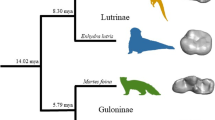Abstract
Allometric analysis of maxillary postcanine tooth area (Y) compared to adult skull length (X) in 34 species of higher primates has revealed a very close relationship. The derived least squares equation is logY=2.223 logX−2.311 with a correlation coefficient of .98. The value of 2.223 for the allometric coefficient suggests that tooth area may be in part related to the amount of food ingested.
Although most of the species examined fit this equation very closely, several could be identified as being slightly deviant. In general, the direction of this deviance can be related to known dietary preferences. Relatively large molars are found in leaf-eaters (Alouatta, Presbytis, Colobus) and in the grass and seed eatingTheropithecus. Relatively small molars are found in primates with insectivorous preferences (Cebuella, Callithrix, Saguinus, andSaimiri) and in one frugivore (Ateles).
The suggestion is made that the amount of mastication required by the preferred food is one factor in determining the most adaptive tooth size.
Similar content being viewed by others
References
Altmann, S. A. &J. Altmann, 1970.Baboon Ecology: African Field Research. University of Chicago Press, Chicago.
Bertrand, M., 1969.The Behavioral Repertoire of the Stumptail Macaque. S. Karger, Basel.
Biggerstaff, R. H., 1966. Metric and taxonomic variation in the dentition of two Asian Cercopithecoid specis ofMacaca.Amer. Journ. Phys. Anthrop., 24: 231–238.
Brody, S., 1945.Bioenergetics and Growth. Hafner Publ. Co., New York.
Carpenter, C. R., 1964.Naturalistic Behavior of Nonhuman Primates. Pennsylvania State University Press, University Park.
Chalmers, N. R., 1968. Group composition, ecology and daily activities of free-living mangabeys in Uganda.Foila primat., 8: 247–262.
Crook, J. H. &P. Aldrich-Blake, 1968. Ecological and behavioral contrasts between sympatric ground dwelling primates in Ethiopia.Folia primat., 8: 192–227.
DeVore, I. &K. R. L. Hall, 1965. Baboon ecology. In:Primate Behavior: Field Studies of Monkeys and Apes,I. DeVore (ed.), Holt, Rinehart, & Winston, New York, pp. 20–52.
Fooden, J., 1966. Identification of the stump-tailed monkey,Macaca speciosa I. Geoffroy 1826.Folia primat., 5: 153–164.
————, 1969.Taxonomy and Evolution of the Monkeys of Celebes (Primates: Cercopithecidae). S. Karger, Basel.
————, 1971. Report on primates collected in western Thailand, January—April 1967.Fieldiana Zoology, 59: 5–62.
Goodall, J., 1965. Chimpanzees of the Gombe Stream Reserve. In:Primate Behavior: Field Studies of Monkeys and Apes,I. DeVore (ed.), Holt, Rinehart, & Winston, New York, pp. 425–473.
Gould, S. J., 1970. Evolutionary paleontology and the science of form.Earth Sci. Rev., 6: 77–119.
————, 1975. On the scaling of tooth size in mammals.Amer. Zoologist, 15: 351–362.
Hershkovitz, P., 1963. A systematic and zoogeographic account of the monkeys of the genusCallicebus (Cebidae) of the Amazonas and Orinoco river basins.Mammalia, 27: 1–80.
Hladik, C. M., 1975. Ecology, diet and social patterning in Old and New World primates. In:Socioecology and Psychology of Primates,R. H. Tuttle (ed.), Mouton Publ., The Hague, pp. 3–35.
Huxley, J. S., 1932.Problems of Relative Growth. Methuen, London.
Hylander, W. L., 1975. Incisor size and diet in anthropoids with special reference to Cercopithecidae.Science, 189: 1095–1098.
Jones, C. &J. Sabater Pí, 1968. Comparative ecology ofCercocebus albigena andCercocebus torquatus.Folia primat., 9: 99–113.
----Jones, C. & ----J. Sabater Pí, 1971. Comparative ecology ofGorilla gorilla (Savage & Wyman) andPan troglodytes (Blumenbach) in Rio Muni, West Africa.Biblio. primat., 13: 1–96.
Kern, J. A., 1964. Observations on the habits of the proboscis monkey,Nasalis larvatus (Wurmb), made in the Brunei Bay area, Borneo.Zoologica, 49: 183–192.
Kinzey, W. G., 1974. Ceboid models for the evolution of hominoid dentition.Journ. Hum Evol., 3: 193–203.
Kleiber, M., 1947. Body size and metabolic rate.Physiol. Rev., 27: 511–541.
————, 1961.The Fire of Life: An Introduction to Animal Energetics. John Wiley & Sons, New York.
Klein, L. L. &D. J. Klein, 1975. Social and ecological contrasts between four taxa of neotropical primates. In:Socioecology and Psychology of Primates,R. H. Tuttle (ed.), Mouton Publ., The Hague, pp. 59–85.
Lindburg, D. G., 1971. The rhesus monkey in North India: an ecological and behavioral study. In:Primate Behavior: Developments in Field and Laboratory Research, Vol. 2,L. A. Rosenblum (ed.), Academic Press, New York, pp. 1–106.
Moynihan, M., 1976.The New World Primates: Adaptive Radiation and the Evolution of Social Behavior, Languages, and Intelligence. Princeton University Press, Princeton.
Pirie, P. L., 1976. Allometry in the masticatory apparatus of primates. Ph. D. Dissertation, The Ohio State University.
Reynolds, V. &F. Reynolds, 1965. Chimpanzees of the Budongo forest. In:Primate Behavior: Field Studies of Monkeys and Apes,I. DeVore (ed.), Holt, Rinehart, & Winston, New York, pp. 368–424.
Rowell, T. E., 1966. Forest-living baboons in Uganda.Journ. Zool., 149: 344–364.
Schaller, G. B., 1961. The orang-utan in Sarawak.Zoologica, 46: 73–82.
Simpson, G. G., A. Roe, &R.C. Lewontin, 1960.Quantitative Zoology. (R. ed.) Harcourt, Brace & Co., New York.
Struhsaker, T. T. &J. F. Oates, 1975. Comparison of the behavior and ecology of red colobus and black-and-white colobus monkeys in Uganda: A summary. In:Socioecology and Psychology of Primates,R. H. Tuttle (ed.), Mouton Publ., The Hague, pp. 103–123.
Tappen, N. C., 1960. Problems of distribution and adaptation of the African monkeys.Cur. Anthrop., 1: 91–120.
Thorington, R. W., Jr., 1967. Feeding and activity ofCebus andSaimiri in a Colombian forest. In:Progress in Primatology,D. Stark,R. Schneider, &H. Kuhn (eds.), Gustav Fischer, Stuttgart, pp. 180–184.
Walker, P. &P. Murray, 1975. An assessment of masticatory efficiency in a series of anthropoid primates with special reference to the Colobinae and Cercopithecinae. In:Primate Functional Morphology and Evolution,R. H. Tuttle (ed.), Mouton Publ., The Hague, pp. 135–150.
Wolpoff, M. H., 1971. A functional measure of tooth size.Southwestern Journ. Anthrop., 27: 279–286.
Author information
Authors and Affiliations
About this article
Cite this article
Pirie, P.L. Allometric scaling in the postcanine dentition with reference to primate diets. Primates 19, 583–591 (1978). https://doi.org/10.1007/BF02373318
Received:
Accepted:
Issue Date:
DOI: https://doi.org/10.1007/BF02373318




